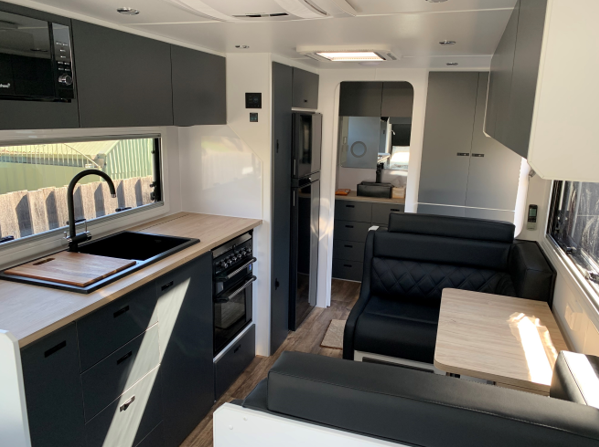Swimming with Manta Rays on the Great Barrier Reef, exploring hidden gorges in Karijini, West Australia, or hitting the red dusty highways of the outback, Australia has a lot to offer. You can do this in style in a recreational vehicle that through good design is a virtual home away from home.
Tiny homes are becoming more prevalent, especially in Europe where living space is at a premium. In China too, there’s a lot of interest in small, compact living spaces. The 34th International Furniture Exhibition in Shenzhen/China saw Hettich’s 18m2 sized Tiny Home win the “Best Whole House Solutions Award.” Hettich say “The less space available, the more intelligent the solutions must be for designing and using it.” There’s no better example of tiny home design than the RV industry that in Australia since COVID, is booming.
The Caravan Industry Association of Australia reported that one in 13 Australian families now own a caravan or camper. More than 800,000 registered RVs took to the road during the first year of the pandemic, making over 4 million trips. A total of 23,931 recreational vehicles (towable and motorised) were manufactured in 2021, representing a significant 42% increase from production outputs in 2020 and these figures will only increase. The wait time for a new caravan is now reported to be twelve months or more.
Consumers are becoming more astute as to what constitutes a good caravan. A pleasant living space was a major selling point in the past, but functionality has now gone to the top of the list of must-haves. It is here that suppliers play a leading role in the creation of a personal, mobile space. For a small space of around fifteen square metres for a 20-foot caravan, appealing surfaces and edge treatments provide a feeling of space and comfort, while hardware delivers the functionality and accessibility necessary to live in a confined space.
The Challenge
The caravan industry is self-regulated and so, quality and build standards vary across the industry. More than ever, the quality of the fitout is becoming more important and critical as caravans venture further into the bush, to iconic drives such as the Oodnadatta Track and the Gibb River Road. It will only be a matter of time before those manufacturers using quality components will become the industry leaders. Already, caravans costing in excess of $130,000 are much sought after for their expected long service life in Australia’s harsh conditions.
A caravan is a smaller version of the home and will usually contain a bedroom, kitchen and seating area, and an ensuite. Throughout the RV, the cabinetry stands out as one of the more important features as it is an important element in holding the RV together. Cabinets are often built with lightweight materials supplied by companies such as Duralite lightweight interior construction system and cut with CNC machines where the front of three or more cabinets are routered as a single component. While the RV cabinet is generally very strong, one of the major complains received by RV manufacturers is cabinet doors not lining up or rubbing against the adjoining door after a few hours on a corrugated road.
The most important part of an RV’s cupboard are its door locks. These must be easy to lock and unlock. Positive locks that require the pushing of a button are best. Piano hinges are often used and touted as superior, but these cannot be easily adjusted and if installed poorly, will produce a very poor result. Concealed cabinet hinges will be much easier to adjust, but take up valuable storage space, another major tiny space issue. The quality of cupboard construction varies between suppliers, with drawers often stapled together, but more often than not, supplied with soft-close runners due to the demands of ever-more astute consumer.
RV Hardware and Surfaces
In an RV, cabinet hardware encompasses the lift mechanism for the bed, the hinges on the doors, door locks, drawer runners, slide-out kitchen pantries, flap stays for lifting bench tops, table legs, gas struts for overhead doors, sinks and tapware, and brackets to hold items onto walls like a TV or a fan. Surfaces in colours or an embossed timber look and feel are another very important element in caravan design. Surfaces set the mood and contribute to the feeling of space. Nikpol is one company supplying surfaces and edge treatments to the RV industry and offers an incredible selection to those companies giving their customers a choice of interior design.
LED lighting is now used in most RVs. It uses only 25% or so of the energy of an incandescent globe, and 50% less than halogen globes. LEDs also provide good illumination. The use of energy in an RV is a serious issue as most basic designs are fitted with AGM batteries that often only allow a day or so off-grid. Lithium batteries are becoming more popular as the cost comes down but at the time of writing, could be in excess of ten thousand dollars for a 400-amp setup with chargers and a 2600-watt inverter. ‘Mood lighting’ is the latest RV trend and consists of LED lighting above, between or behind cupboards, or outside in orange as a deterrent to insects.
Suppliers who have a range of RV specific products on their website include Dorset Australia and Furnware Group that supplies Salice hinges and other products for RV’s. Lincoln Sentry has a range of RV body hardware. Hafele also has a significant stake in the RV industry worldwide. While much of what the industry uses is supplied by companies entirely focused on the RV industry and more often than not, made in China, this is likely to change as the Australian industry aligns with world RV trends and seeks superior products.

